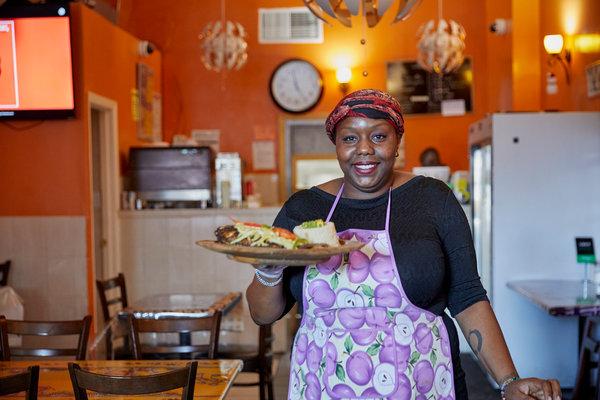For years, Cheick Cisse was just one in a throng of cabdrivers congregating in the morning’s smallest, darkest hours at Ivoire, a bare-bones canteen in Harlem devoted to the food of Ivory Coast, the country where he was born.
Then, in 2006, the owners of Ivoire, cabdrivers themselves, decided to move on. Mr. Cisse took over the restaurant and changed the name to New Ivoire. The customers, mostly fellow Africans (and friends), remained.
But Mr. Cisse always hoped to reach those outside his community as well, to share the food of his childhood with the larger world. Last August, in partnership with Marietou Boleane, a native of Burkina Faso, he opened Paradis des Gouts on the border of Bushwick and Bedford-Stuyvesant in Brooklyn, where fewer West African immigrants live.
The dining room is now adorned with futuristic lamps and paintings of village amphorae, a peacock and the Buddha. Food, served on hand-carved wooden plates, is washed down with housemade juices, including gnamakoudji, ginger pulped and squeezed through cheesecloth, its heat ever so slightly modulated by pineapple juice, lemon, sugar and vanilla: a Creamsicle that ends in flames.

Fatima Dione, the American-raised daughter of a Guinea diplomat, is manager, host and waitress at once, and often steps into the kitchen to help.CreditJohn Kernick for The New York Times
Essential to the table is the Ivorian staple foutou banane, plantains boiled, then beaten repeatedly until stretchy to the touch. This is hard labor. “All the women who do it are strong,” said Fatima Dione, the American-raised daughter of a Guinean diplomat. She is manager, host and waitress at once, and often steps into the kitchen to help the three cooks: Ms. Boleane; Djeinaba Dia, from Senegal; and Laurette Silue, from Ivory Coast.
Pieces of foutou, dense and faintly sweet, are pulled off and dabbed in stew, to drink it up. Its ideal match is sauce graine, whose surface has the sheen of red hematite. The color derives from palm nuts crushed into paste, their scarlet oil rising to the top. The texture on the tongue is lush, messing with diction; you might suddenly find yourself slurring your words.
And here is okra the underestimated, a vegetable that confounds some Americans with its inner tap of mucilage, a viscous liquid shunned as slime. But viscosity has its rewards, turning to voluptuousness in gombo frais, a stew of broken-down tomatoes, palm oil and okra chopped into little rondelles and cooked until the guts melt.
With the stews might come alloco (fried plantains) or riz gras, listed on the menu by its more generally West African name, jollof rice. The grains are fattened and cooked in a soup that’s built from onions fried into a sugary sweat and simmered with garlic, fresh tomatoes and tomato paste, for layers of bright and dark.
Both gombo frais and sauce graine are crowded with giant hunks of beef and smoked turkey, a stand-in for the more profoundly pungent smoked fish that’s a beloved ingredient in West Africa. There will most likely be cow’s foot, too, skin-on, boiled for hours and half gone to jelly. “They put cow’s foot in everything,” said Ms. Dione with a sigh. She didn’t grow up eating it, and protested. “I lost that fight.”
Some of the dishes at Paradis des Gouts.CreditJohn Kernick for The New York Times
Ms. Dione started waitressing at the original Ivoire in Harlem while she was still in college, working from 7 p.m. to 7 a.m., then heading straight to class. It was her mother’s idea: “She wanted me to get in touch with my African roots,” Ms. Dione said.
At Paradis des Gouts, she is an ambassador, explaining dishes to diners mostly unfamiliar with them, like attieke, fermented cassava pulp grated and molded into tiny couscous-like orbs. It has little flavor on its own but arrives topped with raw Scotch bonnets or habaneros: first the burn, then bland consolation.
A foil-wrapped cube of Maggi bouillon stands at the ready, to be crumbled and scattered over the attieke as you will. It tastes of a hundred shades of salt, carnal and marine at once. More Maggi goes into a loose mix of tomatoes and pickled onions, with a dash of clarifying mustard. This is tossed over grilled snapper and nubs of lamb that don’t go gently under the teeth.
“I had one customer say, ‘Too fatty, too many bones,’ ” Ms. Dione said. “Yeah, that’s the appeal. That’s the culture.”
Follow NYT Food on Twitter and NYT Cooking on Instagram, Facebook and Pinterest. Get regular updates from NYT Cooking, with recipe suggestions, cooking tips and shopping advice.




